No Products in the Cart
Dog Hip dysplasia : Symptoms, Treatments and Solutions

Hi Jope's squad !
Did you know that nearly 15% of dogs are affected by hip dysplasia? When the clinical signs and symptoms appear, dog hip dysplasia can be painful. It can also reduce your dog's quality of life—not to mention your own!
From surgery and braces to massage and even CBD, you’ve probably heard about some treatments for dog hip dysplasia already. With so many therapies available, you might wonder what the best treatment is. And are you also curious about the long-term costs? Without further ado, Jope presents a deep dive into dog hip dysplasia.
Everything you need to know about dog hip dysplasia
Dog hip dysplasia is a complex problem. However, here are the main takeaways for dog owners:
- The hip is a joint that needs perfect stability and strong muscles to stay healthy.
- Hip dysplasia is a joint malformation that can appear at some point in your dog’s life.
- Dog hip dysplasia then progresses throughout your dog's life, and it leads to osteoarthritis.
- Hip dysplasia doesn’t necessarily cause any clinical signs. However, osteoarthritis eventually leads to painful symptoms.
- Dog hip dysplasia is more common among large breeds and giant breeds.
- The clinical signs of hip dysplasia vary, and they include difficulties with dogs’ hindquarters.
- Early hip dysplasia diagnosis is essential when vets suspect the disease in at-risk puppies or older dogs.
- Dogs with hip dysplasia don’t always need surgery. However, surgery can be necessary.
- If you can identify hip dysplasia early, you can work closely with your vet to monitor the symptoms. With support, dogs with hip dysplasia can live long lives and maintain a good quality of life.
What is dog hip dysplasia?
Hip dysplasia in dogs is a skeletal disease. It’s a hip malformation that gradually appears at some stage in a dog's life. And it’s essential to remember that dogs are not born with hip dysplasia. However, some breeds are more prone to this health problem than others.
So, when does dog hip dysplasia start? The condition begins with an excessively mobile hip joint. This unusual range of motion is called laxity, and it’s the root cause of this health problem.
The hip joint moves out of place in a process called subluxation. Subluxation affects how force is applied to the hip joint. In turn, these abnormalities lead to inflammation and ongoing damage to the hip joint cartilage, ligaments, and bones. Eventually, as with canine elbow dysplasia, this damage causes osteoarthritis as a side effect.
Can dogs with hip dysplasia live long, healthy lives?
Luckily, even when hip dysplasia causes severe modifications to the hip joints and osteoarthritis, dogs can live long and healthy lives. They can be symptom-free, and the condition isn’t always painful. So, in other words, there’s no close relationship between joint damage and the clinical signs of dog hip dysplasia.
That’s why you shouldn’t lose hope if your dog has hip dysplasia! The good news is that this diagnosis isn’t fatal. So, you don’t have to think about end-of-life care.
Instead, it’s important to understand the basic anatomy of dog hip dysplasia. With proper attention, you can help prevent the problem from getting worse.


A Vet Expert's 5 Reasons to Use Collagen for Dog Joint Health
Collagen is a protein that plays a vital role in the health of our body's connective tissues, including joint cartilage. I will discuss the safety and benefits of collagen for dogs, the different forms it can come in, and my recommendation regarding the best collagen supplement for dog joints.
Learn More
What does dog hip dysplasia look like?
A dog’s hips are the joint that connects their hind legs to their pelvis ( See Picture 1 and Picture 2). You probably know that your dog's hips slightly differ from your own, but the main structures are the same. A socket in the pelvis, called the acetabulum, holds the head of the femur—that’s the upper side of the thigh bone. Normally, this socket perfectly aligns with the bone, and the two never touch. The hip joints require perfect stability and strong muscles to remain healthy for life.
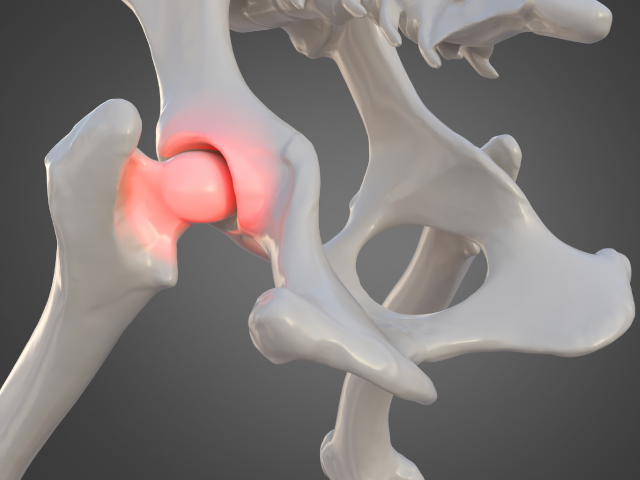
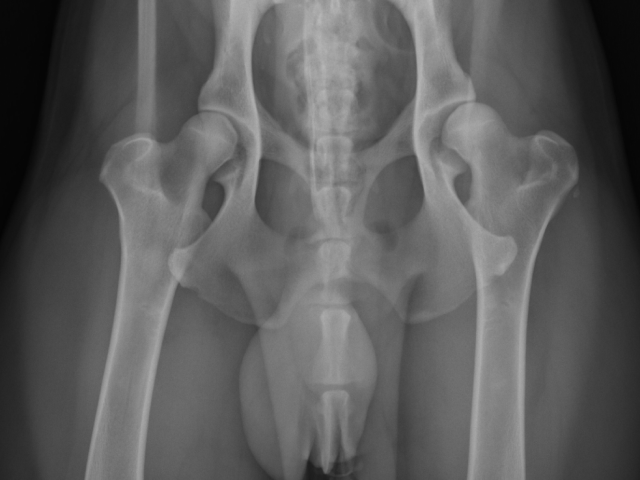
Puppies aren’t born with this condition. So, what exactly causes dog hip dysplasia?
What causes hip dysplasia in dogs?
Although puppies aren’t born with this health problem, dog hip dysplasia is a hereditary disease. It actually involves a large number of genes. However, not all dogs who carry the hip dysplasia genes will ever develop the symptoms. For that reason, it’s hard to avoid hip dysplasia through breeding alone.
In addition, external factors cause dog hip dysplasia. These factors include puppies growing too fast, intense physical activity, or an unnecessarily high-energy diet. Plus, as with many hereditary diseases, some dog breeds face a high risk of developing hip dysplasia.
The 15 dog breeds most at risk for hip dysplasia symptoms
A 2017 study revealed the top 15 breeds affected by canine hip dysplasia (CHD).
Dog breed |
Hip dysplasia rate |
|
Newfoundland |
24.8% |
|
Bloodhound |
24.7% |
|
American Staffordshire terrier |
24.4% |
|
Bullmastiff |
24.0% |
|
Rottweiler |
20.1% |
|
Chesapeake Bay retriever |
19.4% |
|
Chowchow |
19.2% |
|
18.9% |
|
|
Golden retriever |
18.8% |
|
Mastiff |
18.6% |
|
Gordon setter |
18.3% |
|
Old English sheepdog |
17.8% |
|
Giant schnauzer |
17.7% |
|
Pembroke Welsh corgi |
16.6% |
|
Greater Swiss mountain dog |
16.6% |
Dog hip dysplasia can affect any breed, but some breeds and lineages are affected more often than others. As you can see from the breed list above, this disease is more frequent in large breeds.
In this study, scientists analyzed data on more than 1 million dogs from the Orthopedic Foundation for Animals to understand which breeds are most affected by hip dysplasia. According to this study, Great Danes and Labradors don’t rank in the top 15 breeds. However, hip dysplasia was still prevalent among these dogs. In particular, hip dysplasia rates stood at 11.24% for Labradors and 11.62% for great Danes.
The same study also showed that Labrador breeders have done a great job excluding dogs with hip dysplasia from their breeding programs. As a result, they’ve reduced hip dysplasia rates in this breed.
Dog hip dysplasia can also affect smaller breeds, especially:
- English bulldogs.
- Poodles.
- Cocker spaniels.
- Springer spaniels.
Now that you understand which dog breeds are most likely to have hip dysplasia, let’s see how to recognize the clinical signs and symptoms.
What are the signs of hip dysplasia in dogs?
Your dog can start showing the signs of hip dysplasia at different life stages. Indeed, both growing dogs (aged three to 18 months) and mature dogs can have hip dysplasia symptoms. The clinical signs can look like:
- Stiffness in your dog’s hind legs while walking.
- Overall signs of stiffness while running.
- Lameness or limping.
- Discomfort or pain while moving.
- Muscle loss in the rear legs, especially the thighs.
- Reluctance when climbing stairs, running, or jumping.
- Grinding sounds when the joint is moved or mobilized.
- A hard time getting up from a resting position.
- Hip joints with a decreased range of motion.
- Running with a “bunny hop” motion.
First, if this condition has gone undiagnosed for a while, you’ll see a lack of buttocks muscles and prominent hip bones. In puppies with hip dysplasia, you’ll also notice a wobbly or swaying gait.
Your dog might even hop like a rabbit, moving their hind legs together when running. Although these signs can give your dog a “cute” gait, all of these signs are, unfortunately, classic symptoms of dog hip dysplasia.
Although some signs of hip dysplasia are more common, a wide range of other symptoms can appear in dogs of any age. These signs range from stiffness when rising to limping without support, reduced physical activity, a tendency to lie down often, intermittent lameness, and difficulty climbing stairs.


However, if you notice any of these signs, don’t just expect dog hip dysplasia to heal on its own! At the same time, don’t decide on a diagnosis yourself.
For example, if your five-month-old golden retriever is limping, you shouldn’t assume they have hip dysplasia. Instead, bring your puppy to see their veterinarian, and tell your pet care team about your concerns. Your vet will provide a proper diagnosis after a clinical exam and running secondary tests.
How is dog hip dysplasia diagnosed?
We can’t stress enough how critical it is to diagnose dog hip dysplasia early! And this early diagnosis is especially important for at-risk puppies. That’s because some treatments for hip dysplasia are only possible before your dog reaches a certain age. For adult dogs with these symptoms, getting a hip dysplasia diagnosis is still important, and treatment options also exist.
Only veterinarians can confirm a diagnosis of dog hip dysplasia. So, if your pup is one of the at-risk breeds, we recommend planning a special vet appointment to look for the subtle signs and symptoms. However, remember that adult dogs can still develop painful symptoms—even if they showed no signs of the disease as puppies. Because an early diagnosis will help you learn how to improve your dog’s long-term quality of life, we recommend booking a vet appointment early on.
Your veterinarian will base their hip dysplasia diagnosis on several factors, including dog breed, diet, and lifestyle. Also, the symptoms you notice, your dog’s gait and posture, an orthopedic examination (a thorough check-up under anesthesia), and x-ray photos will all help with diagnosis.
In some cases, your regular vet might call on help from specialists. For example, constrained x-rays or hip arthroscopies are performed only by highly specialized veterinary surgeons.
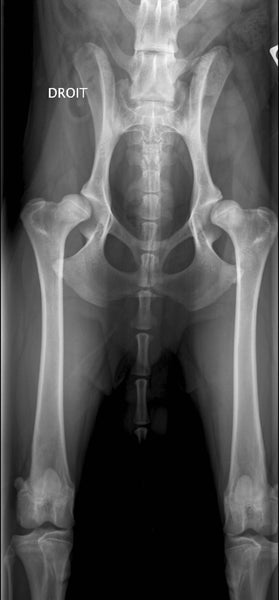

The best treatments for dog hip dysplasia
The best way to treat dog hip dysplasia is to use a combination of exercise, diet, medicine, and joint supplements. Specifically, treatment plans include:
- Lifestyle changes, including weight management.
- Medical treatments, including Non-Steroidal Anti-Inflammatory Drugs (NSAIDs).
- Joint supplements for dogs, including UC-II.
- Canine physiotherapy.
- Hip dysplasia surgery.


Medical treatments to protect your dog's hips
There’s no way around it; dog hip dysplasia requires regular follow-ups with your vet. Because dogs show painful symptoms in different ways, your veterinarian will tailor their treatments to your unique dog.
Some dogs also benefit from lifestyle changes, like adjustments to their food and activities. Meanwhile, other dogs with hip dysplasia need aggressive pain medications to relieve their pain. How long dogs have to stay on medication will vary. Please always rely on your vet’s advice and prescriptions.
When dog hip dysplasia is painful, NSAIDs are the most common treatment. Some of these drugs are okay for long-term use, including the COXIB type and Meloxicam. Of course, drug side effects are always a risk with pain meds. So, you should monitor your pet closely for any changes or side effects.
How to choose joint supplements for dog hip dysplasia
Some joint supplements help support your dog's hip health by reducing inflammation. If inflammation increases, it causes osteoarthritis.
If you’ve done your research, you might have noticed that the most common joint supplements for dogs include chondroitin and glucosamine. But did you know extensive studies have proven that chondroitin and glucosamine are not the best choices to reduce dogs’ pain and inflammation?
Furthermore, these studies showed no objective benefits of using chondroitin and glucosamine for dogs.
On the contrary, omega-3—and especially EPA and DHA—have demonstrated objective results for dogs. These results are objective because they measure the hind legs’ support strength using force plate measurements.
If your dog has hip dysplasia, you should also know that a newer molecule has shown excellent objective results: Undenatured Type II Collagen (UC-II ®). Studies measuring the efficacy of UC-II have also used force plates to measure the hind limbs’ support.
Lifestyle changes to prevent and treat dog hip dysplasia
Maintaining an ideal body weight for your dog is important, and avoiding being overweight is crucial. Is your dog overweight? If so, their hip dysplasia symptoms will get worse fast, and their prognosis won’t be good. That’s because extra weight increases the stress on your dog’s hip joints. And adipocytes produce pro-inflammatory molecules that worsen the situation.
The best lifestyle solution is to regularly exercise your dog, maintaining strong hip muscles. However, be sure to tailor these exercises to your dog’s abilities. If possible, make time for water activities with your furry friend. Physiotherapists recommend aqua therapy for dogs since it reduces pressure on their joints.
Physiotherapy for dogs
We can’t stress enough the importance of physiotherapy for dogs! That’s because veterinary physiotherapy is the equivalent of functional rehabilitation in human medicine.
Simple exercises, including passive range of motion (PROM), help reinforce dogs’ back muscles and proprioception. PROM also improves joints’ and limbs’ possible movement by mindfully stretching specific muscles and tendons. You should perform PROM exercises on your dog a few times every day for a few minutes. These physio exercises will help your furry friend stay strong in the back area, which is the key to managing dog hip dysplasia.
Your veterinary physiotherapist might also recommend some other techniques to reduce pain and inflammation. These treatments can include cryotherapy (cold packs), thermotherapy (warm packs), and laser therapy.
How to deal with hip dysplasia in dogs
Therapy, diet, and careful breeding can help reduce the risk and slow down the worsening of hip dysplasia, including osteoarthritis. But remember: dog hip dysplasia is largely genetic. As a result, it’s impossible to completely prevent the symptoms for all dogs. To deal with dog hip dysplasia:
- Breeders should not breed dogs who have hip dysplasia.
- You should adjust your dog’s food and exercise to avoid obesity and being overweight.
- It’s important to feed puppies a balanced diet that’s tailored to their needs.
- Puppies shouldn’t be allowed to climb stairs in their young age.
- Joint health supplements should be included in your dog’s diet.
Is hip dysplasia surgery the right treatment for your dog?
In some cases, surgery will be necessary for dog hip dysplasia. We strongly advise you to consult with a specialist surgeon. These experts can explain the pros and cons of choosing surgery.

One surgery option is called juvenile pubic symphysiodesis. This surgery is only performed on very young puppies, up to 18–20 weeks old. Because this procedure is very risky, no one should consider it to prevent dog hip dysplasia, only to treat it. That’s because symphysiodesis requires the surgical destruction of a puppy’s pelvic growth plates, modifying the growth pattern. As a result, when the puppy grows up, their hip socket rotates, improving its contact with the femur.
You can also discuss another surgery called a double pelvic osteotomy. This treatment is a recent alternative to a triple pelvic osteotomy. If your dog is five to 10 months old, they might be eligible for this option. That’s why an early diagnosis of hip dysplasia is so important!
Finally, the most common surgeries for dog hip dysplasia are total hip replacement (prosthesis) and femoral head osteotomy (FHO, see Picture 6). However, surgery specialists reserve these treatments for extreme dysplasia cases that don’t get better with conventional treatment. Hip prostheses can work—even for young dogs. And you should only consider removing the head and neck of the femur when it’s necessary to protect your dog.
It’s also important to remember that only your vet can provide the best recommendations for your dog. Treatment plans will always depend on vets’ expert advice.
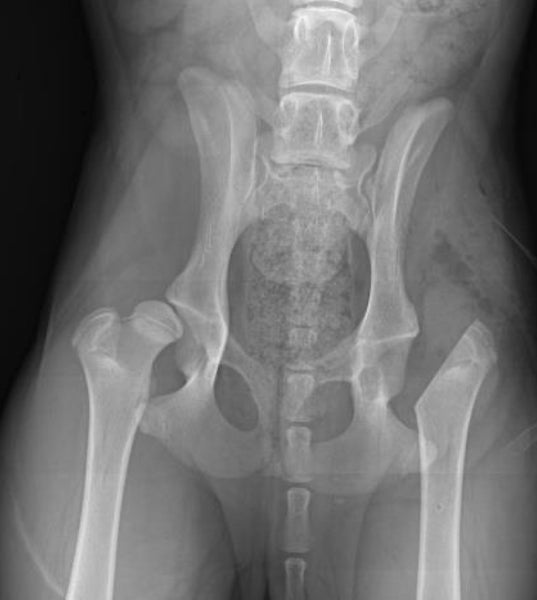
How much does hip dysplasia surgery cost?
With so many surgeries treating dog hip dysplasia, you’re probably wondering how much these surgeries cost. Generally, a total hip replacement for dogs can cost anywhere between $3,500 to $7,000 per hip. The price depends on your dog's condition, size, age, overall health, and operating team.
Meanwhile, the cost of a femoral head osteotomy is lower. This hip dysplasia surgery generally costs between $1,000 and $3,000.
Your vet will help you decide the best treatment for your dog, and their quality of life will be the main priority. That being said, the Jope team understands that treatment costs are an important factor in pet owners’ medical decisions.
If your fur baby has hip dysplasia, you might also be wondering about the long-term outlook and symptoms. Here’s what you can expect.
What’s the prognosis for dog hip dysplasia?
Good news! Dog hip dysplasia is not fatal or even necessarily painful. So, if your pup is diagnosed with hip dysplasia, don’t panic. With proper follow-up and care, dogs with hip dysplasia can live long, happy lives. The key is to carefully monitor the disease and make informed decisions to treat the symptoms.
However, if your dog starts limping and favoring their hind legs, something else might be causing their lameness.
So, if you notice your puppy or dog limping, bring them in to see a veterinarian. The diagnosis will depend on a clinical exam and additional tests.
Also, your vet will perform an orthopedic examination and x-ray your dog’s hips. Depending on their findings, the next steps might include specific x-rays and hip arthroscopy under general anesthesia. If this step is recommended, your dog will be monitored carefully as they recover from going under. Then, you’ll be able to take them home within 24 hours of their surgery.
If your dog needs surgery for hip dysplasia, you’ll also want recommendations for post-operative care. Here are some treatments you’ll need to know about.

Picture 8 - CT-scan and 3D reconstruction showing hip dysplasia in an adult dog with osteoarthritis. (Toulouse Veterinary School)
Dog hip dysplasia: What post-surgery care is recommended?
Dog hip dysplasia doesn't necessarily present clinical signs or require a specific surgery. For that reason, our advice is to discuss treatments with your veterinary team when the time is right. And because dog hip dysplasia doesn't necessarily need surgery, we don't recommend considering the costs and impact of surgery right away. Instead, the best option is to speak with your veterinarian. Together, you can decide the best course of action.
Finally, if applicable, your veterinary team will also recommend post-surgery treatments. The suggested treatments can include dog foods, supplements, and even physiotherapy. Plus, your vet team will discuss the costs of these treatments so that you can be ready with a plan. You should refer to their detailed report after your dog’s hip dysplasia surgery.
At Jope, our goal is to guide you on a deep dive into your dog’s conditions. If you have questions, please feel free to email us .
Disclaimer: Our article (like any other website) does not replace your veterinarian’s advice or diagnosis. Indeed, your veterinarian is your best ally in taking care of your best friend! We can only give general advice. For more specific advice related to your dog’s conditions, please reach out to your veterinarian. Our UC-II product is scientifically proven to “help support companion animals’ joint health and mobility” and “support joints and connective tissue to help improve flexibility and mobility for adult and senior dogs.”












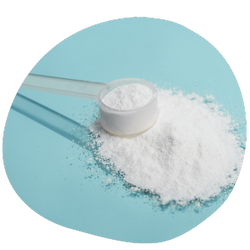
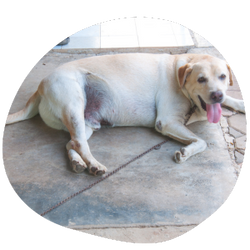

Leave a comment